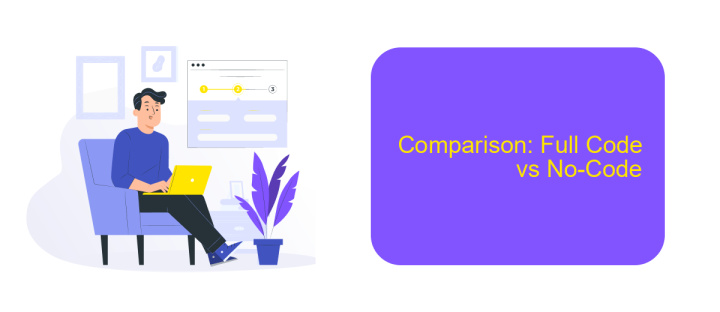Full Code vs No-Code
In the rapidly evolving landscape of software development, the debate between full code and no-code solutions is gaining momentum. Full code offers unparalleled flexibility and customization, allowing developers to create complex, tailored applications. Conversely, no-code platforms democratize app development, enabling non-technical users to build functional software quickly and efficiently. This article explores the strengths and limitations of both approaches.
Introduction
The debate between full code and no-code development has gained significant traction in recent years. As businesses strive for efficiency and agility, the choice between these two approaches becomes crucial. Full code development offers unparalleled customization and control, while no-code platforms promise speed and accessibility for non-developers.
- Full Code: Allows for intricate, highly tailored solutions.
- No-Code: Enables rapid development with minimal technical knowledge.
- Integration: Tools like ApiX-Drive simplify the connection between various applications, bridging the gap between full code and no-code environments.
Understanding the strengths and limitations of each approach can guide businesses in making informed decisions. Whether opting for the robust capabilities of full code or the user-friendly nature of no-code, the ultimate goal remains the same: to create efficient, scalable, and effective solutions that meet organizational needs.
Understanding Full Code

Full Code development involves writing detailed, custom code to create software applications. This approach provides developers with the highest level of control and flexibility, allowing them to build complex functionalities and tailor every aspect of the application to specific needs. Developers use various programming languages, frameworks, and tools to write, test, and deploy their code. The process often requires a deep understanding of algorithms, data structures, and system architecture.
One of the significant advantages of Full Code is the ability to integrate with other systems and services seamlessly. For instance, developers can use services like ApiX-Drive to set up and manage integrations between different applications efficiently. ApiX-Drive simplifies the process by providing a user-friendly interface and pre-built connectors, reducing the time and effort needed to establish connections. This flexibility is crucial for businesses that require customized solutions to meet their unique operational needs.
Understanding No-Code

No-code platforms have revolutionized the way businesses and individuals create software applications. By eliminating the need for traditional coding skills, these platforms empower users to develop functional applications through intuitive, visual interfaces. This democratization of software development allows for rapid prototyping and deployment, reducing the time and cost associated with traditional development processes.
- Drag-and-drop interfaces simplify the design process.
- Pre-built templates and modules accelerate development.
- Integration capabilities with other software and services enhance functionality.
One of the significant advantages of no-code platforms is their ability to integrate with various external services seamlessly. Tools like ApiX-Drive facilitate these integrations by allowing users to connect different applications without writing a single line of code. This capability ensures that businesses can automate workflows, synchronize data, and enhance operational efficiency effortlessly. As a result, no-code platforms become a powerful ally for organizations looking to innovate quickly and effectively.
Comparison: Full Code vs No-Code

When comparing Full Code and No-Code approaches, it's essential to understand their fundamental differences. Full Code development involves writing extensive code, offering limitless customization and control, but it demands significant technical expertise and time investment. On the other hand, No-Code platforms enable users to build applications using visual interfaces, making development accessible to non-programmers.
Full Code development is ideal for complex projects requiring unique features and integrations. It allows developers to optimize performance, security, and scalability. Conversely, No-Code solutions are suitable for rapid prototyping and simple applications, reducing the time to market and lowering costs.
- Customization: Full Code offers unparalleled customization, while No-Code provides limited flexibility.
- Development Speed: No-Code significantly speeds up development, whereas Full Code can be time-consuming.
- Technical Expertise: Full Code requires advanced programming skills, while No-Code is user-friendly.
- Integration: Full Code can integrate with any system, while No-Code often relies on services like ApiX-Drive for seamless integrations.
Ultimately, the choice between Full Code and No-Code depends on the project's complexity, budget, and timeline. For businesses needing quick, cost-effective solutions, No-Code platforms are invaluable. However, for intricate, highly customized applications, Full Code remains the preferred choice.
Conclusion
In conclusion, the choice between full code and no-code solutions largely depends on the specific needs and resources of your project. Full code offers unparalleled flexibility and control, making it ideal for complex, custom applications that require precise functionality. However, it demands significant time and technical expertise. On the other hand, no-code platforms democratize software development, enabling individuals with little to no programming knowledge to create functional applications quickly and efficiently. This approach is particularly beneficial for startups and small businesses looking to innovate without extensive investment in technical resources.
Moreover, no-code solutions often come with built-in integrations and automation tools, such as ApiX-Drive, which streamline the process of connecting various services and applications. This can significantly reduce development time and enhance productivity. Ultimately, the decision should be guided by the specific requirements, budget, and technical capabilities of your team, ensuring that the chosen approach aligns with your overall business objectives.
FAQ
What is the main difference between Full Code and No-Code?
Who should use No-Code platforms?
Can No-Code platforms handle complex integrations?
What are the limitations of No-Code platforms?
How can I automate processes and integrate different tools without coding?
Apix-Drive will help optimize business processes, save you from a lot of routine tasks and unnecessary costs for automation, attracting additional specialists. Try setting up a free test connection with ApiX-Drive and see for yourself. Now you have to think about where to invest the freed time and money!

